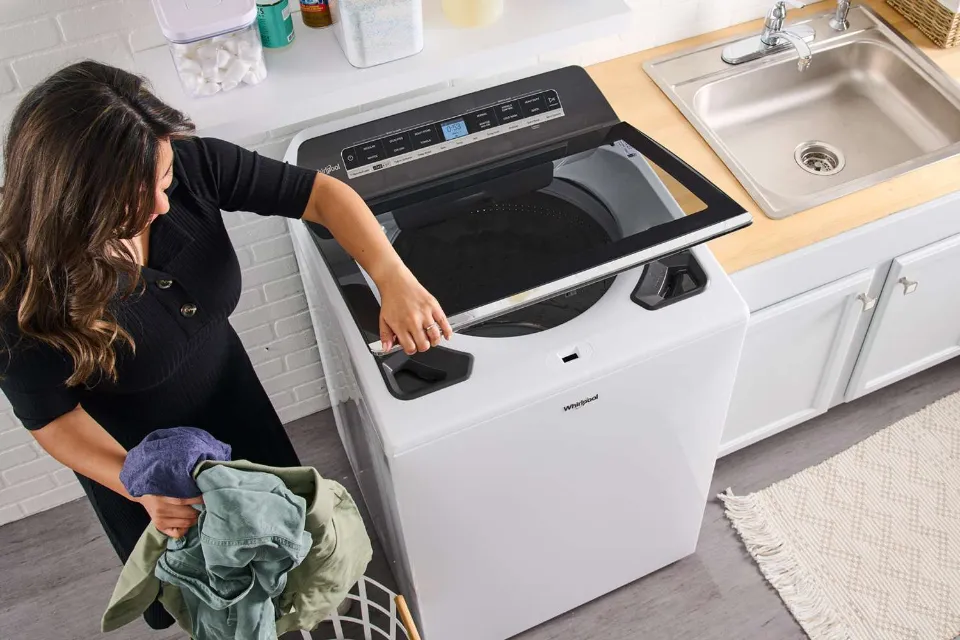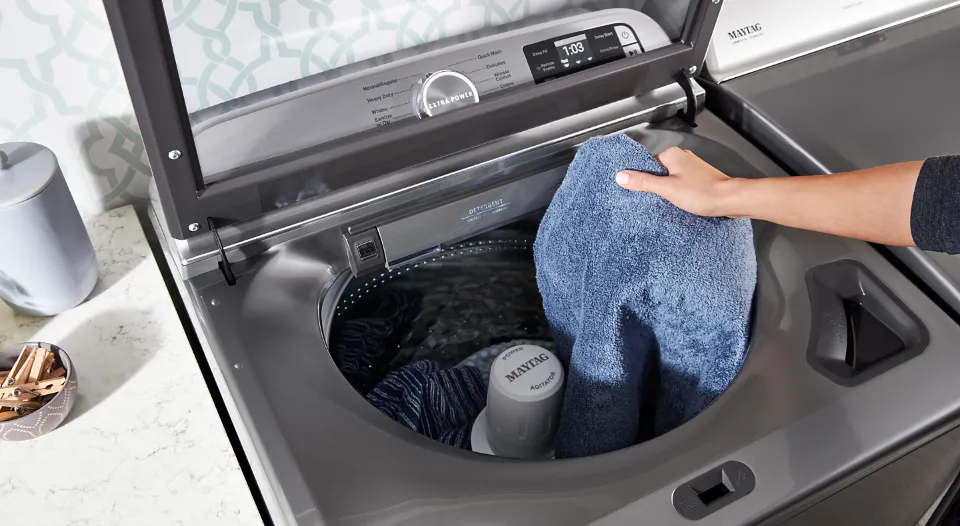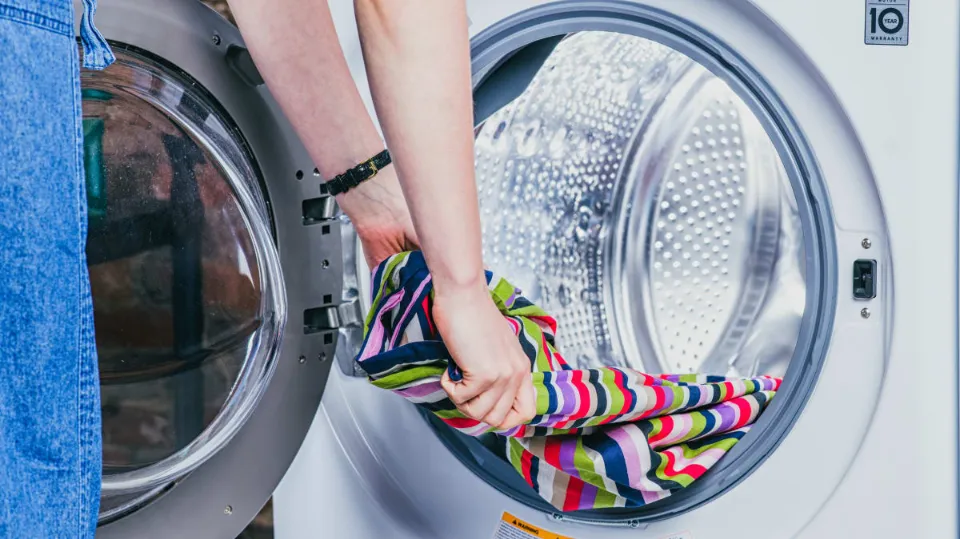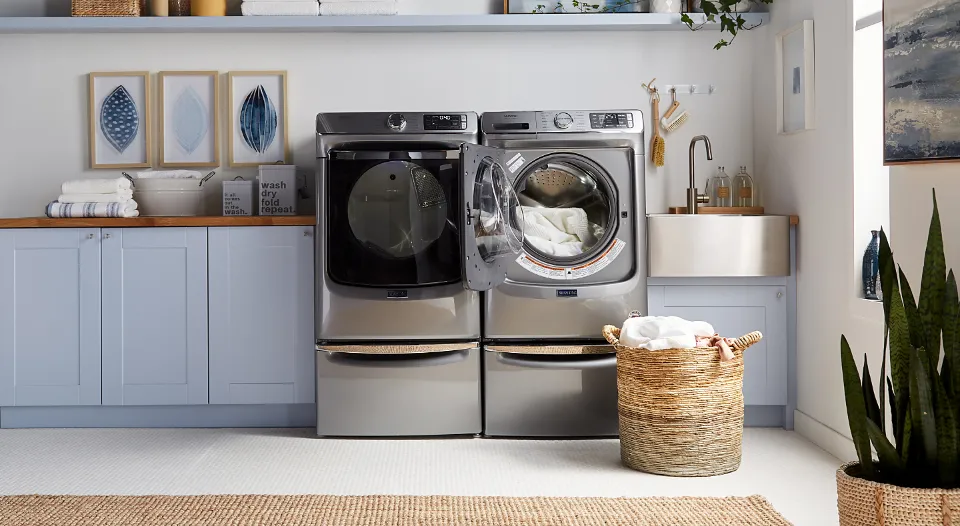STo begin with, how to drain washing machine? If your machine isn’t draining properly, you’ll have to drain it yourself before attempting to repair it.
How to drain washing machine? Open the lid, unplug the washer and turn off the water, remove the clothing, place buckets, set up a water siphon, and drain the washing machine drum.
Please read on for more detailed information.
How to Drain Washing Machine? Top-loading Washing Machine
If your top-loading washer did not drain by unblocking the drain hose or initiating drain prompts, siphon the water into buckets with a hose.
Open the Lid
Activate the washing machine’s lid. If the lid does not open, the water inside may need to cool down before the automatic lid sensor (found on select machines) allows the lid to open.

Unplug the Washer and Turn Off the Water
You can now unplug the device with the lid open. The plug’s end must remain dry at all times. Cut off the water supply to the washing machine at the hot and cold faucets.
Remove the Clothing
The clothing should be taken out of the water if the drum contains any. Put the clothes in the buckets.
Place Buckets
Place two buckets next to each other in front of the washing machine.
Set Up a Water Siphon
Make a siphon to transfer the water in the drum that is standing to one of the buckets. Make use of a tidy 4- to 6-foot hose. Remove the hot or cold fill hose from the washing machine if one isn’t already there.
- Take one hand and clasp the two ends together.
- In the utility sink or bathtub, completely fill the hose with water.
- The washing machine drum should receive the hose’s open end. Force it to the bottom. Keep the other end of the hose higher than the level of the water that is still in the washer drum.
- Put the hose’s other end into a bucket right away. The siphon should automatically start.

Drain the Washing Machine Drum
The hose should be moved to the second bucket once the first bucket is nearly full. Drain the first bucket in the laundry room utility sink or bathtub and bring it back. Work quickly and repeat this cycle until the washing machine is completely drained.
How to Drain Washing Machine? Front-loading Washing Machine
Here is an easy step-by-step guide on how to drain washing machine:
Turn Off the Power
If your model has a power button, press it to turn it off. Unplug the washer from the power source. Duct tape the power cord to the top of the machine to avoid splashing it with water or getting caught under the machine.

Locate the Drain Pump Filter And/or Drain Tube
You’ll typically find one of two configurations in front-load washers: either a single drain pump filter that filters debris and releases extra water, or a drain pump filter and a separate drain hose. This setup will typically be located behind an access panel on the bottom of the front of the machine; depending on your model, you may need to unscrew this front panel, unclip it, or simply flip it down.
Drain the Water
Whether your washing machine has a filter only or a filter and drain tube will determine how you should drain a washing machine.
- If you have a drain pump filter only, place a towel on the floor and a shallow container like a baking dish against the washing machine, directly below the filter to catch the water. Slowly turn the knob of the drain pump filter counterclockwise to remove the filter; water will begin to spill out. Keep the filter partially in place while the water drains; if you fill the container before the water stops flowing, you’ll need to be able to quickly close it while you empty the container. Repeat this process until all of the water has been removed.
- If your appliance includes both a filter and drain tube, place the towel and a shallow container underneath the drain hose. When you are prepared to release the water, release the drain tube from its placement by unscrewing the end cap. Keep the cap in one hand so you can quickly and easily stop the flow of water if your container fills up. When all the water has been drained, replace the cap and clip the hose back in.
Clean the Filter
After you’ve drained the washing machine, remove any buildup of solid material from the filter by hand. Then rinse the filter with a soft-bristled brush and warm water. Replace the filter and the access panel.
Know When to Call in a Pro
When you have checked that the drain hose is not kinked and that neither the drain pump hose nor the drain pump filter appear to be clogged, you have done your due diligence and it may be time to call a professional.

Safety Considerations
Avoid moving the machine. Even a moderately sized 4.2 cubic foot machine full of water weighs close to 200 pounds. If you need to move the machine a few inches to access the back of the machine, have an assistant help you. Call a serviceman in the alternative.
What’s Causing the Draining Problem?
Once you have drained the machine, investigate the usual suspects that could have caused the problem:
- Drain hose obstruction: If water did not immediately pour out of the hose when you lowered it into the bucket, a blockage is almost certainly present. To get rid of the obstruction, use the plumber’s snake.
- Clog in the drain pump: This obstruction may be more difficult to clear. For information on how to access the drain pump, consult your owner’s manual. Usually found in the front or back of the machine, the drain pump is concealed behind a detachable panel. With your needle-nose pliers, unclog any obstructions.
- A good way to reduce buildup is to make sure you’re using the right amount of detergent.

Tips for Draining a Washer Without Water Going Everywhere
You’ve probably already guessed that draining a washing machine is a bit of a messy task. This is especially true if you have a front loader with a low-lying drain pipe. Let’s recap our top tips for minimizing mess:
- Raise the machine: Elevate the machine if you can using bricks or wooden blocks.
- Lay down tarp: A tarp can contain water while protecting your floors.
- Lay down absorbent towels: Please feel free to use a lot of towels to clean up any spills; we won’t think you’re crazy.
- Use the right depth of storage container: Even though it might be tempting to use a deep bucket, a shallow tray will fit underneath the drain pipe more easily, especially for front-loading washing machines. Just remember that in order to prevent overflow, you’ll need to empty it every minute or so.
- Empty it slowly: Until you have your bucket ready, use caution when using a top loader to point the drain hose upward. The water will automatically exit the hose as soon as you point it downward. Remove the drain filter for front-loading washing machines gradually to prevent a sudden burst of water.

FAQs
Can You Force a Washer to Drain?
If your filter is only a drain pump, set the shallow container up against the machine, right underneath the filter, to collect the water. Turn the knob slowly until water starts coming out. Fill the container, turn the knob off, dump the water into a sink or basin, and repeat until the water has been drained completely.
How Do I Get My Washer to Drain and Spin?
Inspecting the drain hose should be your first step if your washer won’t drain. Water won’t be able to flow out if this component is blocked, frozen, or bent, which will result in all of the liquid remaining in the tub. Make sure the drain hose isn’t kinked or twisted in a way that obstructs the flow of water.
Summary: How to Drain Washing Machine?
There are several drain override prompts and manual methods for draining the washer, regardless of whether it is a top-loading or front-loading machine.
How to drain washing machine? Open the lid, unplug the washer and turn off the water, remove the clothing, place buckets, set up a water siphon, and drain the washing machine drum.
Please leave a comment if you have any questions. My Prime Home tries to give you the best furniture information. I really appreciate your reading.
You may want to know:



